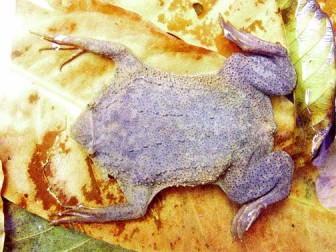T he Suriname Toad (Pipa pipa) could be one of the strangest frogs you might see in the rainforest; in fact it’s not a toad but an aquatic dwelling frog. Its body is freakishly flattened with a small triangular head and it has flaps of skin or short tentacles on the upper lip near the eyes. Its forefeet have four fingers which end with star-like appendages used to feel around for food and the hind legs are broadly webbed without claws. It has a large mouth with no teeth or tongue and its eyes are very small but give vision in all directions. The skin is a grey/green mottle or sometimes blackish brown which blends the frog well into its environs. These frogs can be found in pools with high detritus content near lakes and small creeks, in swampy areas that exist mainly in second growth and mixed forest.
The Suriname Toad rarely leaves the water and is mainly nocturnal (active during the night). Its usual diet consists of water bugs, small fish and fine worms. Unlike other animals that call to indicate location, Pipa pipa are usually silent, resting very still on the bottom of the watery home. Instead, the males give a series of rapid clicks when it is mating season. And again, unlike many frogs, the Suriname Toad carries its eggs around during development.
After fertilization, the eggs are deposited on the back of the female where they develop in little chambers formed in the soft skin. At some point in the development the tadpole grows a tail which it uses in the exchange of oxygen. After the tadpole completely metamorphoses, a fully formed frog emerges from the pockets on its mother’s back! The species surfaces every half hour to breathe and the juveniles would spend more time at the surface of the water until they learn to dive and surface like the adults.

This species is threatened by habitat loss and pollution but is currently listed as least concerned by the International Union for Conservation of Nature (IUCN).
Rain forests are rich in biodiversity and are home to many different plants and animals. In addition, indigenous communities make their homes there. Even if you don’t live in the rain forest, humans rely on the forest for resources such as building materials (wood and lianas), medicine and fruits. Rain forests also provide essential environmental services for life on earth; they create soil as well as prevent soil erosion, produce oxygen though photosynthesis, maintain clean water systems, and are a key defence against climate change.
The Iwokrama Rain Forest is 371,000 hectares, located in the heart of Guyana. Our mission is to develop strategies for conservation and sustainable development for local people in Guyana and the world at large. We are involved in tourism, training, research and our timber is certified by the Forest Stewardship Council. Come and visit us in the rain forest or at http://www.iwokrama.org.




